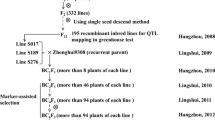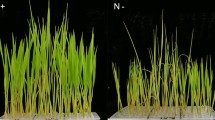Abstract
Boron toxicity tolerance of rice plants was studied. Modern japonica subspecies such as Koshihikari, Nipponbare, and Sasanishiki were tolerant, whereas indica subspecies such as Kasalath and IR36 were intolerant to excessive application of boron (B), even though their shoot B contents under B toxicity were not significantly different. Recombinant inbred lines (RILs) of japonica Nekken-1 and indica IR36 were used for quantitative trait locus (QTL) analysis to identify the gene responsible for B toxicity tolerance. A major QTL that could explain 45% of the phenotypic variation was detected in chromosome 4. The QTL was confirmed using a population derived from a recombinant inbred line which is heterogenic at the QTL region. The QTL was also confirmed in other chromosome segment substitution lines (CSSLs).






Similar content being viewed by others
References
Blamey FPC, Asher CJ, Edwards DG (1997) Boron deficiency in sunflower. In: Bell RW, Rerkasem B (eds) Boron in Soils and Plants. Kluwer, Dordrecht, pp 145–149
Cayton MTC (1985) Boron toxicity in rice. IRRI Res Pap Ser 113:2–10
Chantachume Y, Smith D, Hollamby GJ, Paull JG, Rathjen AJ (1995) Screening for boron tolerance in wheat (T. aestivum) by solution culture in filter paper. Plant Soil 177:249–254
Conley EJ, Nduati V, Gonzalez-Hernandez JL, Mesfin A, Trudeau-Spanjers M, Chao S, Lazo GR, Hummel DD, Anderson OD, Qi LL, Gill BS, Echalier B, Linkiewicz AM, Dubcovsky J, Akhunov ED, Dvorrák J, Peng JH, Lapitan NLV, Pathan MS, Nguyen HT, Ma XF, Miftahudin, Kalavacharla V, Kianian SF, Sidhu D, Dilbirligi M, Gill KS, Choi DW, Fenton RD, Close TJ, McGuire PE, Qualset CO, Anderson JA (2004) A 2600-locus chromosome bin map of wheat homoeologous group 2 reveal interstitial gene-rich islands and colinearity with rice. Genetics 168: 625–637
Ebitani T, Takeuchi T, Nonoue Y, Yamamoto T, Takeuchi K, Yano M (2005) Construction and evaluation of chromosome segment substitution lines carrying overlapping chromosome segments of indica rice cultivar Kasalath in a genetic background of japonica elite cultivar Koshihikari. Breed Sci 55:65–73
Garg OK, Sharma AN, Kona GR (1979) Effect of boron on the pollen vitality and yield of rice plants. Plant Soil 52:591–594
Gupta UC (1983) Boron deficiency and toxicity symptoms for several crops as related to tissue boron levels. J Plant Nutr 6:387–396
Hayes JE, Reid RJ (2004) Boron tolerance in barley is mediated by efflux of boron from the roots. Plant Physiol 136:3376–3382
Hewitt EJ (1966) The composition of the nutrient solution. In: Sand and Water Culture Methods Used in the Study of Plant Nutrition. Farnham Royal Bucks, Commonwealth Agricultural Bureaux, England, pp 190
Ishizuka Y, Tanaka A (1962) Inorganic nutrition of the rice plant. 7. Effect of boron, zinc and molybdenum level in culture solution on yields and chemical composition of the plant. Jpn J Soil Sci Plant Nutr 33:93–96
Jefferies SP, Barr AR, Karakousis A, Kretschmer JM, Manning S, Chalmers KJ, Nelson JC, Islam AKMR, Langridge P (1999) Mapping of chromosome regions conferring boron toxicity tolerance in barley (Hordeum vulgare L.). Theor Appl Genet 98:1293–1303
Jefferies SP, Pallotta MA, Paull JG, Karakousis A, Kretschmer JM, Manning S, Islam AKMR, Langridge P, Chalmers KJ (2000) Mapping and validation of chromosome regions conferring boron toxicity tolerance in wheat (Triticum aestivum). Theor Appl Genet 101:767–777
Kaur S, Nicolas ME, Ford R, Norton RM, Taylor PWJ (2006) Selection of Brassica rapa genotypes for tolerance to boron toxicity. Plant Soil 285:115–123
Manly KF, Cudmore RH Jr, Meer JM (2001) Map Manager QTX, cross platform software for genetic mapping. Mamm Genome 12:930–932
Matoh T, Akaike R, Kobayashi M (1997) A sensitive and convenient assay for boron in plant using chromotropic acid and HPLC. Plant Soil 192:115–118
McCouch SR, Teytelman L, Xu Y, Lobos KB, Clare K, Walton M, Fu B, Maghirang R, Li Z, Xing Y, Zhang Q, Kono I, Yano M, Fjellstrom R, DeClerck G, Shneider D, Cartinhour S, Ware D, Stein L (2002) Development and Mapping of 2240 new SSR markers for rice (Oryza sativa L.). DNA Res 9:199–207
Mengel K, Kirkby EA (2001) Boron. In: Principles of Plant Nutrition, 5th edn. Kluwer, Dordrecht, pp 621–638
Nable RO (1988) Resistance to boron toxicity amongst several barley and wheat cultivars: A preliminary examination of the resistance mechanism. Plant Soil 112:45–52
Nable RO, Bañuelos GS, Paull JG (1997) Boron toxicity. Plant Soil 193:181–198
Nakazki T, Ikehashi H (1998) Genomic sequence and polymorphisms of a rice chitinase gene, Cht4. Breed Sci 48:371–376
Nelson JC (1997) QGENE: software for marker-based genomic analysis and breeding. Mol Breed 3:239–245
Paliwal KV, Mehta KK (1973) Interactive effect of salinity, SAR and boron on the germination and growth of seedlings of some paddy (Oryza sativa) varieties. Plant Soil 39:603–609
Paull JG, Cartwright B, Rathjen AJ (1988) Responses of wheat and barley genotypes to toxic concentrations of soil boron. Euphytica 39:137–144
Paull JG, Rathjen AJ, Cartwright B (1991) Major gene control of tolerance of bread wheat (Triticum aestivum L.) to high concentrations of soil boron. Euphytica 55:217–228
Ponnamperuma FN, Yuan WL (1966) Toxicity of boron to rice. Nature 211:780–781
Ponnamperuma FN, Cayton MT, Lantin RS (1981) Dilute hydrochloric acid as an extractant for available zinc, copper and boron in rice soils. Plant Soil 61:297–310
Power PP, Woods WG (1997) The chemistry of boron and its speciation in plants. Plant Soil 193:1–13
Reid RJ, Hayes JE, Post A, Stangoulis JCR, Graham RD (2004) A critical analysis of the causes of boron toxicity in plants. Plant Cell Environ 25:1405–1414
Roessener U, Patterson JH, Forbes MG, Fincher GB, Langridge P, Bacic A (2006) An investigation of boron toxicity in barley using metabolomics. Plant Physiol 142:1087–1101
Schnurbusch T, Collins NC, Eastwood RF, Sutton T, Jefferies SP, Langridge P (2007) Fine mapping and targeted SNP survey using rice-wheat gene colinearity in the region of the Bo1 boron toxicity tolerance locus of bread wheat. Theor Appl Genet 115:451–461
Stein N, Prasad M, Scholz U, Thiel T, Zhang H, Wolf M, Kota R, Varshney RK, Perovic D, Grosse I, Graner A (2007) A 1, 000-loci transcript map of the barley genome: new anchoring points for integrative grass genomics. Theor Appl Genet 114:823–839
Sutton T, Baumann U, Hayes J, Collins NC, Shi BJ, Schnurbusch T, Hay A, Mayo G, Pallotta M, Tester M, Langridge P (2007) Boron-toxicity tolerance in barley arising from efflux transporter amplification. Science 318:1446–1449
Tokuoka M, Dyo S (1938) Über den einfluss des bors auf das wachstum der reispflanze. III. Nettai Nougaku Kwaishi 10:151–157
Tokuoka M, Morooka H (1936) Über den einfluss des bors auf das wachstum der reispflanze. I. Jpn J Soil Sci Plant Nutr 10:189–199
Yanagihara S, McCouch SR, Ishikawa K, Ogi Y, Maruyama K, Ikehashi H (1995) Molecular analysis of the inheritance of the S-5 locus, conferring wide compatibility in Indica/Japonica hybrids of rice (O. sativa L.). Theor Appl Genet 90:182–188
Acknowledgments
This work was supported financially by a grant from the Ministry of Agriculture, Forestry and Fisheries of Japan (Green Technology Project IP-5003) and a Grant-in-Aid from JSPS to T. Matoh (No. 19380043).
Author information
Authors and Affiliations
Corresponding author
Additional information
Communicated by L. Xiong.
Rights and permissions
About this article
Cite this article
Ochiai, K., Uemura, S., Shimizu, A. et al. Boron toxicity in rice (Oryza sativa L.). I. Quantitative trait locus (QTL) analysis of tolerance to boron toxicity. Theor Appl Genet 117, 125–133 (2008). https://doi.org/10.1007/s00122-008-0758-7
Received:
Accepted:
Published:
Issue Date:
DOI: https://doi.org/10.1007/s00122-008-0758-7




